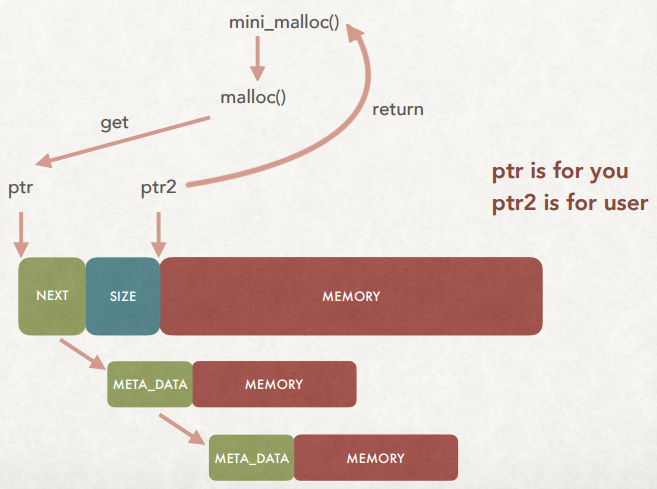Memory
Why am I doing this lab?
- Learn how Valgrind works
- Learn memory layout and how malloc/free works
- How does free know how many bytes it has to free?
Memory Offsets \ in C
typedef struct{
int n1;
float n2;
char st[10];
} contact;
int main(){
contact fred;
printf("Contact address:\t%p\n", &fred);
printf("Contact n1 location:\t%p\n", &fred.n1);
printf("Contact n2 location:\t%p\n", &fred.n2);
printf("Contact nst location:\t%p\n", &fred.st);
return 0;
}
$ gcc main.c -o stack
$ ./stack
Contact address: 0x7ffcc8568b40
Contact n1 location: 0x7ffcc8568b40
Contact n2 location: 0x7ffcc8568b44
Contact nst location: 0x7ffcc8568b48
What does this mean?
- Your compiler calculates offsets from the base address of your contact (in this case,
fred) - It knows that the first element is at offset 0, the second element is at offset +4, the third element is at offset +8, and so on
Cool, So What does this have to do with Malloc?
malloc does the same thing, but on the heap
typedef struct{
int n1;
float n2;
char st[10];
} contact;
int main(){
contact* fred = malloc(sizeof(*fred));
printf("Contact address:\t%p\n", fred);
printf("Contact n1 location:\t%p\n", &fred->n1);
printf("Contact n2 location:\t%p\n", &fred->n2);
printf("Contact nst location:\t%p\n", &fred->st);
free(fred);
return 0;
}
$ gcc malloc-main.c -o malloc-main
$ ./malloc-main
Contact address: 0x1bcd010
Contact n1 location: 0x1bcd010
Contact n2 location: 0x1bcd014
Contact nst location: 0x1bcd018
Right But What Does this have to do with our Malloc?
- As you’ll encounter in this lab, one way of keeping track of memory is via metadata tags
- To accomplish this, we allocate more memory than the user requests
- We’ll use pointer arithmetic to make sure that we return the right pointer to the user
What’s in the #tags?
Information about the current block of memory:
- Pointer to next link, if using a linked list
- Size of block
- Whatever else you want…
Splitting and coalescing
- Reduce memory wastage!
- How can we use tags to split a block?
- How can we use tags to merge adjacent blocks?
Understanding how to do this will be useful when you implement malloc!
The Big Picture


Hints
-
meta_data * head: head for linked-list -
total_memory_requested: keep track of bytes used -
total_memory_freed: keep track of bytes freed - Think about how to create a linked-list and insert/remove
- Insert has to be constant time, but free doesn’t
- Have to catch bad calls to free and increment
invalid_addresses
Hey! Shouldn’t we not be able to do arithmetic with void pointers?
- Technically yeah, but gcc and clang treats it as a
char* - In short, don’t do it because the standard doesn’t guarantee it